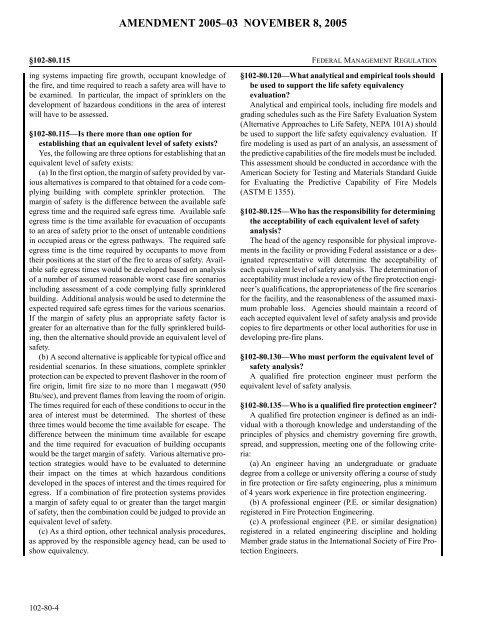FEDERAL MANAGEMENT REGULATION - GSA
FEDERAL MANAGEMENT REGULATION - GSA
FEDERAL MANAGEMENT REGULATION - GSA
Create successful ePaper yourself
Turn your PDF publications into a flip-book with our unique Google optimized e-Paper software.
AMENDMENT 2005–03 NOVEMBER 8, 2005<br />
§102-80.115 <strong>FEDERAL</strong> <strong>MANAGEMENT</strong> <strong>REGULATION</strong><br />
ing systems impacting fire growth, occupant knowledge of<br />
the fire, and time required to reach a safety area will have to<br />
be examined. In particular, the impact of sprinklers on the<br />
development of hazardous conditions in the area of interest<br />
will have to be assessed.<br />
§102-80.115—Is there more than one option for<br />
establishing that an equivalent level of safety exists?<br />
Yes, the following are three options for establishing that an<br />
equivalent level of safety exists:<br />
(a) In the first option, the margin of safety provided by various<br />
alternatives is compared to that obtained for a code complying<br />
building with complete sprinkler protection. The<br />
margin of safety is the difference between the available safe<br />
egress time and the required safe egress time. Available safe<br />
egress time is the time available for evacuation of occupants<br />
to an area of safety prior to the onset of untenable conditions<br />
in occupied areas or the egress pathways. The required safe<br />
egress time is the time required by occupants to move from<br />
their positions at the start of the fire to areas of safety. Available<br />
safe egress times would be developed based on analysis<br />
of a number of assumed reasonable worst case fire scenarios<br />
including assessment of a code complying fully sprinklered<br />
building. Additional analysis would be used to determine the<br />
expected required safe egress times for the various scenarios.<br />
If the margin of safety plus an appropriate safety factor is<br />
greater for an alternative than for the fully sprinklered building,<br />
then the alternative should provide an equivalent level of<br />
safety.<br />
(b) A second alternative is applicable for typical office and<br />
residential scenarios. In these situations, complete sprinkler<br />
protection can be expected to prevent flashover in the room of<br />
fire origin, limit fire size to no more than 1 megawatt (950<br />
Btu/sec), and prevent flames from leaving the room of origin.<br />
The times required for each of these conditions to occur in the<br />
area of interest must be determined. The shortest of these<br />
three times would become the time available for escape. The<br />
difference between the minimum time available for escape<br />
and the time required for evacuation of building occupants<br />
would be the target margin of safety. Various alternative protection<br />
strategies would have to be evaluated to determine<br />
their impact on the times at which hazardous conditions<br />
developed in the spaces of interest and the times required for<br />
egress. If a combination of fire protection systems provides<br />
a margin of safety equal to or greater than the target margin<br />
of safety, then the combination could be judged to provide an<br />
equivalent level of safety.<br />
(c) As a third option, other technical analysis procedures,<br />
as approved by the responsible agency head, can be used to<br />
show equivalency.<br />
§102-80.120—What analytical and empirical tools should<br />
be used to support the life safety equivalency<br />
evaluation?<br />
Analytical and empirical tools, including fire models and<br />
grading schedules such as the Fire Safety Evaluation System<br />
(Alternative Approaches to Life Safety, NEPA 101A) should<br />
be used to support the life safety equivalency evaluation. If<br />
fire modeling is used as part of an analysis, an assessment of<br />
the predictive capabilities of the fire models must be included.<br />
This assessment should be conducted in accordance with the<br />
American Society for Testing and Materials Standard Guide<br />
for Evaluating the Predictive Capability of Fire Models<br />
(ASTM E 1355).<br />
§102-80.125—Who has the responsibility for determining<br />
the acceptability of each equivalent level of safety<br />
analysis?<br />
The head of the agency responsible for physical improvements<br />
in the facility or providing Federal assistance or a designated<br />
representative will determine the acceptability of<br />
each equivalent level of safety analysis. The determination of<br />
acceptability must include a review of the fire protection engineer’s<br />
qualifications, the appropriateness of the fire scenarios<br />
for the facility, and the reasonableness of the assumed maximum<br />
probable loss. Agencies should maintain a record of<br />
each accepted equivalent level of safety analysis and provide<br />
copies to fire departments or other local authorities for use in<br />
developing pre-fire plans.<br />
§102-80.130—Who must perform the equivalent level of<br />
safety analysis?<br />
A qualified fire protection engineer must perform the<br />
equivalent level of safety analysis.<br />
§102-80.135—Who is a qualified fire protection engineer?<br />
A qualified fire protection engineer is defined as an individual<br />
with a thorough knowledge and understanding of the<br />
principles of physics and chemistry governing fire growth,<br />
spread, and suppression, meeting one of the following criteria:<br />
(a) An engineer having an undergraduate or graduate<br />
degree from a college or university offering a course of study<br />
in fire protection or fire safety engineering, plus a minimum<br />
of 4 years work experience in fire protection engineering.<br />
(b) A professional engineer (P.E. or similar designation)<br />
registered in Fire Protection Engineering.<br />
(c) A professional engineer (P.E. or similar designation)<br />
registered in a related engineering discipline and holding<br />
Member grade status in the International Society of Fire Protection<br />
Engineers.<br />
102-80-4

















